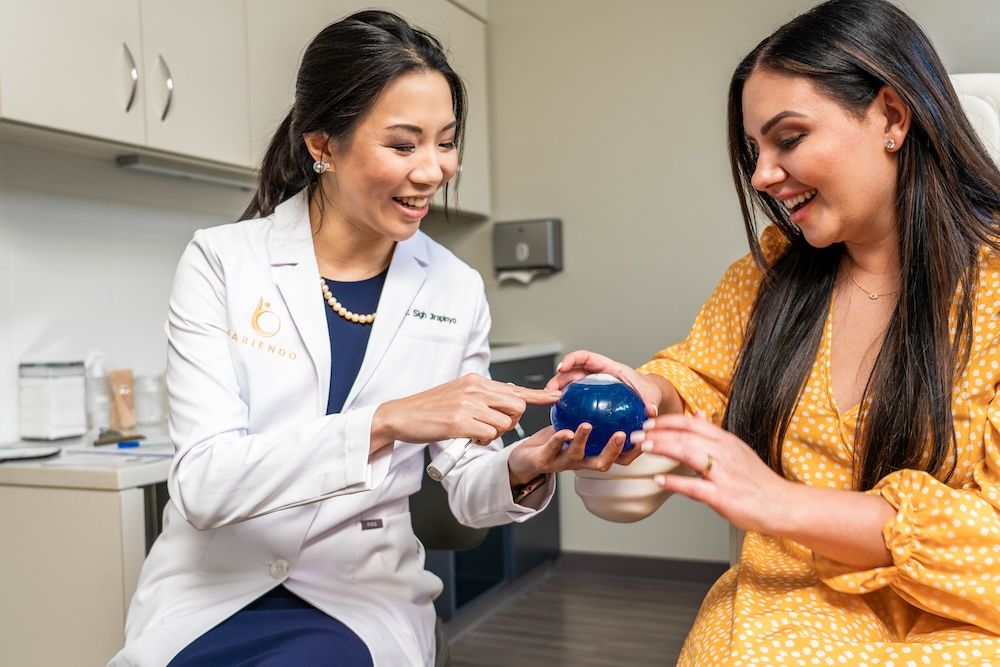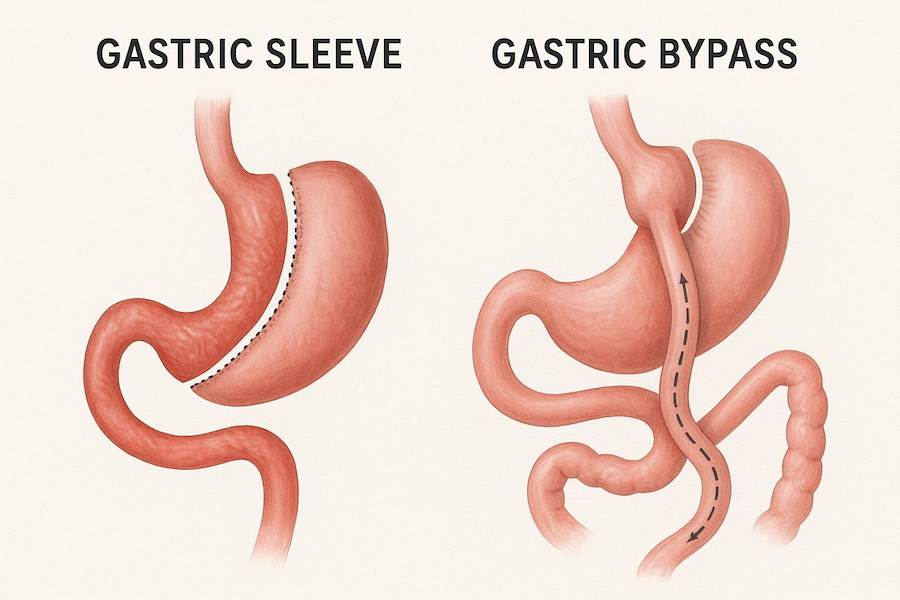5 Gastric Balloon Types Explained: Which One is Best?
Compare 5 common gastric balloon types, how they work, and which one may be best for your weight loss goals. Learn what to expect and how to choose wisely.

Bariendo Team
Team @ Bariendo
The intragastric balloon (IGB) can be a powerful tool for jumpstarting weight loss without the need for surgery. But if you’ve started researching your options, you’ve probably noticed that there’s more than one type of gastric balloon to choose from.
Some are swallowable. Others are adjustable. They typically stay in place for six months, but it can vary. And with so many variables, figuring out which gastric balloon is the best for you can seem a bit overwhelming.
This guide breaks down the five most common intragastric balloon types, how they work, and what makes each one unique. These insights will help you compare your options confidently and ask the right questions as you take the next step.
5 Different Types of Gastric Balloon Compared
The different types of gastric balloons all work toward the same goal—helping you feel full sooner so you can eat less without feeling deprived, ultimately leading to gradual weight loss. But the way they get there isn’t always the same.
Below, we’ll break down the five most common gastric balloon types to help you compare your options and ask the right questions.
1. The Orbera Weight-Loss Balloon
The Orbera balloon is one of the most widely used gastric balloons worldwide—and one of the most studied. It’s designed to help you eat less by taking up space in your stomach, so you feel full sooner and stay satisfied longer.The procedure is quick and non-surgical. The balloon is inserted through the mouth using an endoscope, then filled with sterile saline once it’s in place. The entire process takes about 15 minutes, and most patients return home the same day.Most patients take 1-3 days off of work before returning to their normal routine.. Some people experience mild nausea, cramping, or discomfort during the first week, but these symptoms tend to subside quickly as the body adjusts.The Orbera balloon stays in the stomach for six months. Removal is also done endoscopically and typically takes about 15 minutes. Most patients lose about 10% of their total body weight during this period, especially when combined with lifestyle coaching and nutritional support.Orbera is FDA-approved and a good fit for people who want a proven, short-term weight loss tool that doesn’t require surgery.
2. Spatz3 Adjustable Balloon
The Spatz3 balloon stands out for one key reason: it’s the only gastric balloon that can be adjusted after placement. That means your provider can increase or decrease the balloon’s volume based on how your body responds, which may help improve comfort and results over time.
Like Orbera, Spatz3 is placed endoscopically during a quick, outpatient procedure. It’s then inflated with saline and left in the stomach to create a sense of fullness. The entire process typically takes about 30 minutes, and most patients go home the same day.
Spatz3 can remain in the stomach for up to 8 months, which is longer than most other balloon options. This extended duration allows for more time to build sustainable habits and track long-term progress.
The recovery period is similar to other balloon types, with temporary symptoms like nausea, cramping, or fatigue during the first few days. If the balloon feels too uncomfortable—or if weight loss plateaus—the volume can be adjusted mid-treatment.
The balloon is removed via endoscopy at the end of the 8-month period. On average, patients lose around 10–15% of their total body weight, depending on adherence to diet and lifestyle changes.
Spatz3 is FDA-approved and a strong option for patients who want a longer treatment window or more flexibility to fine-tune their progress along the way.
3. ReShape Balloon
While you may find some outdated information about the ReShape balloon system online, it’s important to know that it was discontinued in 2018 and is no longer available. This system was similar to the Obera intragastric balloon, but consisted of two separate balloons.
4. Obalon Balloon System
The Obalon system takes a different approach from traditional gastric balloons. Instead of one balloon placed endoscopically, Obalon uses a series of small, swallowable balloons that are filled with gas (not liquid) after they reach the stomach.
The process starts with swallowing a small capsule attached to a thin catheter. Once it reaches the stomach, a provider inflates the balloon with gas. This is repeated up to three times over a few weeks, depending on your treatment plan. No sedation or endoscopy is required for placement—though removal still requires a short endoscopic procedure.
Obalon balloons stay in place for a total of six months. Because the system uses gas-filled balloons, they tend to feel lighter and may be more comfortable for some patients. However, they require more time for repeated placements, and they are more expensive than Orbera.
Most patients experience temporary side effects like nausea or bloating in the first few days. These symptoms usually subside as the body adapts.
On average, patients lose around 6% to 10% of their total body weight, which is slightly lower than some other gastric balloon types. However, Obalon may be a good fit for people who want a swallowable, non-surgical solution with minimal downtime and no sedation for placement. The system is FDA-approved and works best when combined with structured lifestyle support.
5. Allurion Balloon
The Allurion (formerly Elipse) Balloon offers a completely non-invasive approach to weight loss—but it’s not yet FDA-approved for use in the United States. While widely used in Europe and other countries, it’s currently considered an emerging option for the U.S. market.
What makes Allurion different is that it doesn’t require any sedation, anesthesia, or endoscopy. Instead, the balloon is delivered in a small capsule attached to a thin catheter, which is swallowed in a provider’s office. Once the capsule reaches the stomach, the balloon is filled with fluid through the catheter, which is then removed.
The balloon stays in the stomach for about 16 weeks (roughly 4 months) and then naturally deflates and passes through the digestive system—so no removal procedure is needed.
Most patients experience mild nausea, cramping, or bloating in the first few days, but symptoms generally resolve quickly. The balloon is not adjustable, and its shorter duration may not be ideal for those needing longer-term support.
In clinical studies, patients lost around 10% of their total body weight when the balloon was paired with lifestyle coaching and dietary support. While Allurion is not yet available in the U.S., it may become a future option for patients seeking a non-invasive weight loss solution.
Which Gastric Balloon Is The Best?
Patients currently have three FDA-approved options available in the US: Orbera, Obalon, and Spatz3. Each type of gastric balloon offers a different experience, and the best fit will depend on your goals, health history, and guidance from your medical provider
- Orbera is a saline-filled, single-balloon system placed via endoscopy in a one-time outpatient procedure. It stays in place for six months and is known for its strong clinical backing and consistent weight loss results. Removal is also done endoscopically under light sedation.
- Obalon is a gas-filled, swallowable balloon system. Up to three balloons are swallowed over several weeks, each inflated during a quick office visit guided by X-ray. While no sedation is needed for placement, the balloons are removed together with a short endoscopic procedure under sedation. Weight loss results are typically more modest compared to saline options.
- Spatz3 is the only adjustable gastric balloon currently available in the U.S. It’s placed endoscopically and can remain in the stomach for up to eight months. Its main advantage is that your provider can adjust the balloon’s volume after placement, allowing for more flexibility, improved comfort, and better support if weight loss plateaus during treatment.
At Bariendo, your decision will be guided by a team of experts in non-surgical weight loss. We’ll walk you through the differences and recommend the best fit based on your health, preferences, and long-term goals.
Who Qualifies for an Intragastric Balloon?
If you’ve been working hard to lose weight but haven’t seen the results you hoped for, a gastric balloon could be a strong next step—especially if you’re looking for a non-surgical option that supports real, sustainable change.
Gastric balloons are typically a good fit for people who:
- Have a BMI over 30, or a BMI of 27-29.9 with an obesity-related health conditioon
- Are ready to build long-term healthy habits but need extra support to get started
- Have tried other weight loss methods without lasting success
- Prefer a non-surgical, temporary approach with a focus on education and follow-up care
At Bariendo, gastric balloon procedures are performed by experienced providers and supported by a team of registered dietitians and nurse practitioners. From your first consultation to your final follow-up, you’ll have access to expert care and personalized coaching to help you stay on track.
Before moving forward, our providers will review your medical history to make sure a gastric balloon is safe and appropriate for you. Some conditions—like previous stomach surgeries or digestive issues—may affect eligibility, but many patients find they qualify.
If you think a gastric balloon might be the right step, take this short quiz to see if you qualify.
Do You Still Feel Hungry with a Gastric Balloon?
One of the most common questions patients ask is, “Will I still feel hungry?” The short answer: yes, but it’s different.
Gastric balloons are designed to help you feel full sooner and longer after eating, thanks to the space they take up in your stomach. You’ll still feel hunger cues, but they tend to be milder and more manageable. Most patients notice they’re satisfied with smaller portions and feel full faster—without feeling deprived.
It’s also common for your appetite to shift over time. In the first few days after placement, your body is adjusting, and you may have less interest in food due to temporary side effects like nausea or bloating. As those symptoms fade, your appetite usually stabilizes at a lower level.
The key to long-term success isn’t just what the balloon does—it’s what you learn during the process. At Bariendo, patients receive ongoing support from dietitians and medical providers to help them understand their hunger signals, build balanced meals, and feel confident navigating real-life situations.
So yes, you’ll still feel hunger—but in a way that’s easier to manage, giving you more control and the tools to build lasting habits.
Will Insurance Cover a Gastric Balloon?
In most cases, insurance does not cover gastric balloon procedures, as they are often considered elective weight loss treatments.
At Bariendo, we are committed to providing transparent and comprehensive pricing. Our gastric balloon program is priced at $7,495, which includes:
- Balloon Placement and Removal: Both procedures are performed by our experienced medical team.
- 12-Month Follow-Up Care: Regular virtual visits to monitor your progress and provide ongoing support.
- Personalized Support from Registered Dietitians: Guidance to help you develop sustainable, healthy habits.
- Smart Scale for At-Home Tracking: A tool to help you monitor your weight loss journey.
To make this investment more accessible, Bariendo offers flexible financing options through our partner, Cherry Financing. This allows you to choose a payment plan that fits your budget, with options including 0% interest plans and extended payment terms for qualified patients.
Finding the Right Fit Starts with the Right Support
There’s a lot to consider when choosing a gastric balloon—how it’s placed, how long it lasts, what kind of follow-up care you’ll receive.
At Bariendo, we take the time to understand your goals, answer your questions, and recommend options that fit both your lifestyle and your health needs. You’ll be supported by a team that’s not only experienced, but deeply committed to helping you succeed.
Schedule a free consultation with our team to explore the different types of gastric balloons and learn which one might be the best fit for you.

